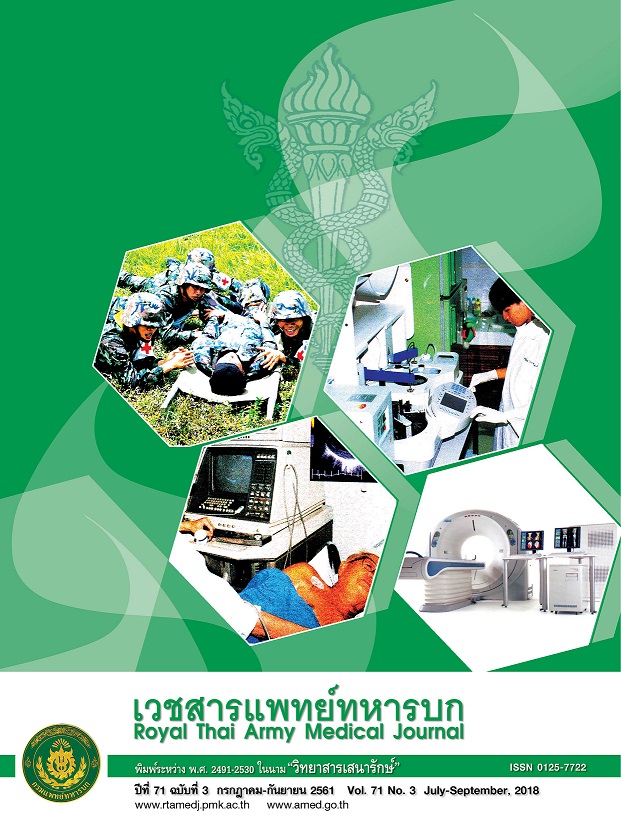Evaluation and Testing of Semi-automatic Tourniquet
Main Article Content
Abstract
Introduction: The insurgency in southern Thailand has caused great loss to army troops. One of the most common traumas is threatening limb injuries. The tourniquet is one method that can stop bleeding effectively and save lives. However, the elastic rubber tourniquets currently used retain many disadvantages. Objective: To determine time to stop bleeding at all limbs using the new semi-automatic tourniquet. Methods: An experimental research was conducted involving sergeant medics from the Army Medical Field Service School of the Royal Thai Army Medical Department. The elastic rubber tourniquet and the new semi-automatic tourniquet were compared regarding time needed to stop blood perfusion at the arms and legs. The study was conducted in both self-usage form and do-to-others form. Also, satisfaction with the new semi-automatic tourniquet was assessed. Results: The study enrolled a total of 16 participants. Concerning self-usage, a significant difference was found regarding time needed to stop blood perfusion between the elastic rubber tourniquet and the semi-automatic tourniquet at p-value < 0.001. The semi-automatic tourniquet could stop blood perfusion faster with an average time of 10.74 seconds at the arm and 8.38 seconds at the leg while the elastic rubber tourniquet took 23.84 and 17.57 seconds for both the arm and leg. In the experiment-to-others form, the semi-automatic tourniquet (8.55 seconds) could stop blood perfusion faster than the elastic rubber tourniquet (13.31 seconds) at the arm but no difference was found in time between these tourniquets at the leg. Satisfaction for the new semi-automatic tourniquet was assessed as maximum. Conclusion: The new semi-automatic tourniquet could stop bleeding faster than the elastic rubber tourniquet. This tourniquet could be further developed and adjusted to serve as portable life-saving equipment for combat personnel, which can be self-used for threatening limb injuries and furnish another option concerning life-saving methods.
Article Details
References
[เข้าถึงเมื่อ9 ก.ค.2559]; เข้าถึงได้จาก: http://www.deepsouthwatch.org/node/7942.
วรสิทธิ์ ศรศรีวิชัย. รายงานสถานการณ์การเฝ้าระวังการบาดเจ็บจากความรุนแรงในพื้นที่จังหวัดชายแดนภาคใต้ (Violence-related Injury Surveillance - VIS) ประจำเดือน มกราคม 2550 ถึง ธันวาคม 2552 [อินเทอร์เน็ต]. 2553 [เข้าถึงเมื่อ 9 ก.ค.2559]; เข้าถึงได้จาก: http://medipe2.psu.ac.th/~vis/report/VIS_Report_Jan07_Dec09.pdf
American College of Surgeons. PHTLS: Prehospital trauma life support. 8th ed. Massachusetts: Jones & Bartlett learning; 2016:218-43.
Bulger EM, Snyder D, Schoelles K, Gotschall C, Dawson D, Lang E, McSwain N. An evidence-based prehospital guideline for external hemorrhage control: American College of Surgeons Committee on Trauma. Prehospital Emergency Care. 2014;18:163-73.
American College of Surgeons. ATLS: Advanced trauma life support, student course manual. 9th ed. Illinois: Hearthside Publishing Services; 2012.
National Association of Emergency Medical Technicians (NAEMT). Tactical combat casualty care guidelines for medical personnel [Internet]. 2016 [cited 2016 Jun 20]; Available from: http://www.naemt.org/education/TCCC/guidelines_curriculum
กองวิทยาการ กรมแพทย์ทหารบก. ค่มู ือปฏิบัติการพยาบาล นายสิบพยาบาลชกท. 911 และ ชกท. 912. พิมพ์ครั้งที่ 3. 2554.
สำนักงานระบบการบริการการแพทย์ฉุกเฉิน กระทรวงสาธารณสุข. คู่มือวิทยากรหลักสูตรเวชกรรมฉุกเฉินระดับพื้นฐาน. พิมพ์ครั้งที่ 3. 2556.
Walters TJ, Mabry R. Issues related to the use of tourniquets on the battlefield. Military Medicine. 2005;170:770-5.
Mabry R. Tourniquet use on the battlefield. Military Medicine. 2006;171:352-6.
Jeyaseelan S, Stevenson TM, Pfitzner J. Tourniquet failure and arterial calcification. Anaesthesia. 1981;36:48-50.
ธนานันต์ อิศรางกูร ณ อยุธยา. โครงการวิจัยนำร่องการพัฒนาสายรัดห้ามเลือดชนิดกึ่งอัตโนมัติ. กรุงเทพฯ: กองอุบัติเหตุและเวชกรรมฉุกเฉิน โรงพยาบาลพระมงกุฎเกล้า; 2555.
Hill JP, Montgomery LD, Hopper KW, Roy LA. Evaluation of Self-Applied Tourniquets for Combat Applications, Second Phase. NEDU TR 07-07, Navy Experimental Diving Unit, Apr 2007.

